Nursing Mental Health
VerifiedAdded on 2023/03/17
|6
|1362
|84
AI Summary
This essay focuses on a patient named Alison who is suffering from depression and underwent a mental status examination (MSE). The findings reveal her appearance, behavior, mood, and thoughts, leading to a diagnosis of major depression. A treatment plan is proposed, including a recovery-oriented approach and addressing financial and relationship issues. The use of mental state examination (MSE) is highlighted as a valuable tool for assessment and diagnosis in mental health.
Contribute Materials
Your contribution can guide someone’s learning journey. Share your
documents today.
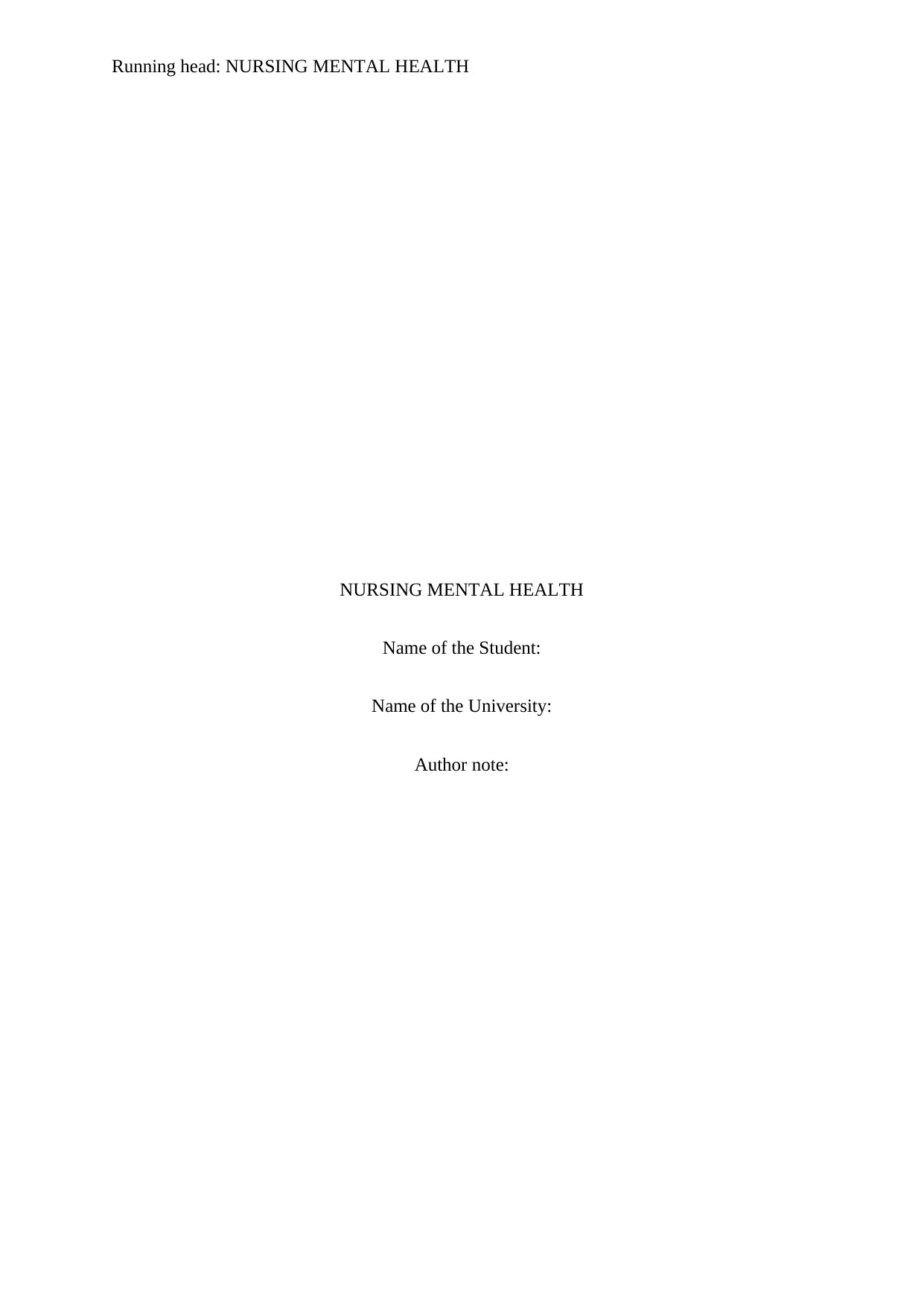
Running head: NURSING MENTAL HEALTH
NURSING MENTAL HEALTH
Name of the Student:
Name of the University:
Author note:
NURSING MENTAL HEALTH
Name of the Student:
Name of the University:
Author note:
Secure Best Marks with AI Grader
Need help grading? Try our AI Grader for instant feedback on your assignments.
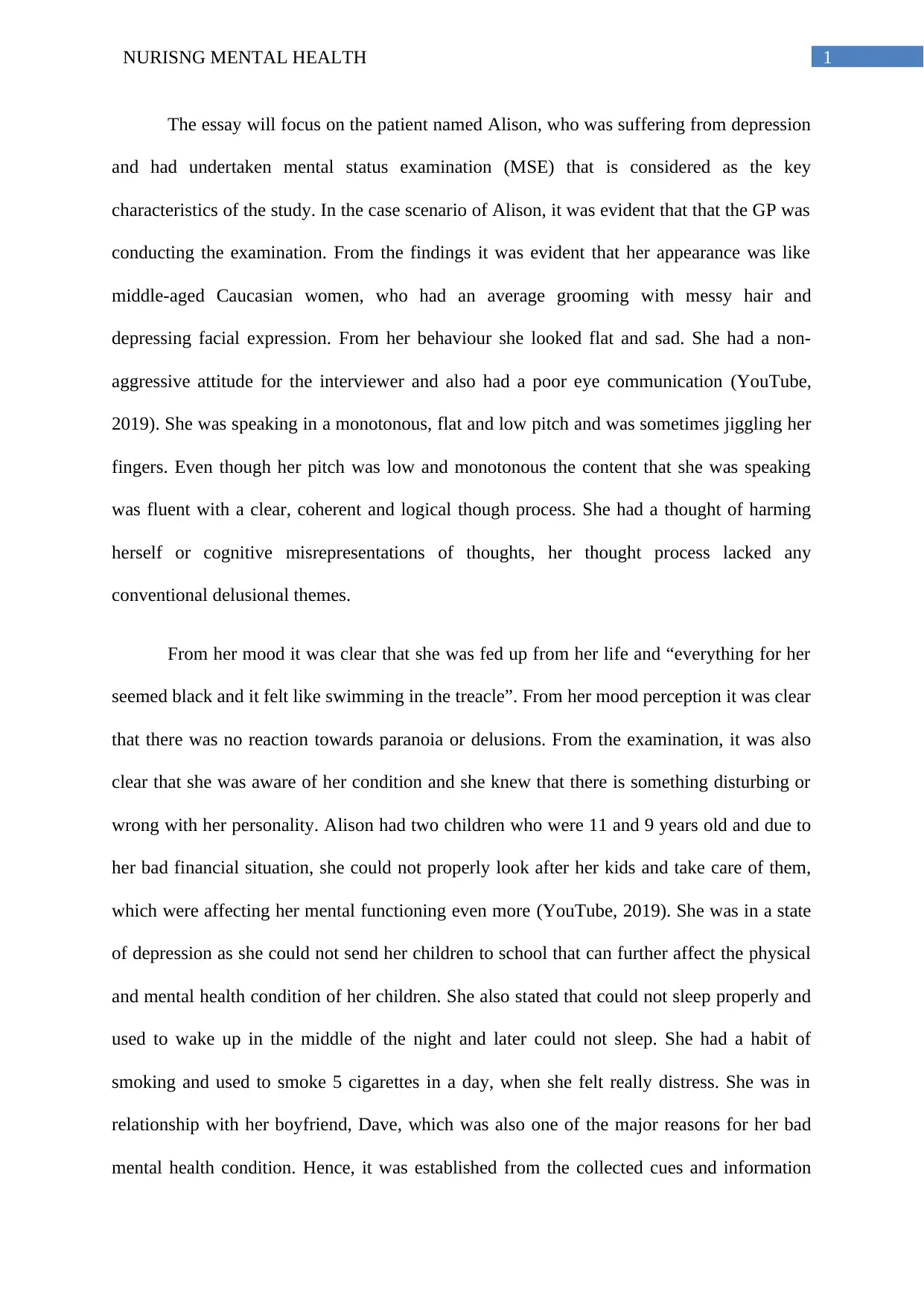
1NURISNG MENTAL HEALTH
The essay will focus on the patient named Alison, who was suffering from depression
and had undertaken mental status examination (MSE) that is considered as the key
characteristics of the study. In the case scenario of Alison, it was evident that that the GP was
conducting the examination. From the findings it was evident that her appearance was like
middle-aged Caucasian women, who had an average grooming with messy hair and
depressing facial expression. From her behaviour she looked flat and sad. She had a non-
aggressive attitude for the interviewer and also had a poor eye communication (YouTube,
2019). She was speaking in a monotonous, flat and low pitch and was sometimes jiggling her
fingers. Even though her pitch was low and monotonous the content that she was speaking
was fluent with a clear, coherent and logical though process. She had a thought of harming
herself or cognitive misrepresentations of thoughts, her thought process lacked any
conventional delusional themes.
From her mood it was clear that she was fed up from her life and “everything for her
seemed black and it felt like swimming in the treacle”. From her mood perception it was clear
that there was no reaction towards paranoia or delusions. From the examination, it was also
clear that she was aware of her condition and she knew that there is something disturbing or
wrong with her personality. Alison had two children who were 11 and 9 years old and due to
her bad financial situation, she could not properly look after her kids and take care of them,
which were affecting her mental functioning even more (YouTube, 2019). She was in a state
of depression as she could not send her children to school that can further affect the physical
and mental health condition of her children. She also stated that could not sleep properly and
used to wake up in the middle of the night and later could not sleep. She had a habit of
smoking and used to smoke 5 cigarettes in a day, when she felt really distress. She was in
relationship with her boyfriend, Dave, which was also one of the major reasons for her bad
mental health condition. Hence, it was established from the collected cues and information
The essay will focus on the patient named Alison, who was suffering from depression
and had undertaken mental status examination (MSE) that is considered as the key
characteristics of the study. In the case scenario of Alison, it was evident that that the GP was
conducting the examination. From the findings it was evident that her appearance was like
middle-aged Caucasian women, who had an average grooming with messy hair and
depressing facial expression. From her behaviour she looked flat and sad. She had a non-
aggressive attitude for the interviewer and also had a poor eye communication (YouTube,
2019). She was speaking in a monotonous, flat and low pitch and was sometimes jiggling her
fingers. Even though her pitch was low and monotonous the content that she was speaking
was fluent with a clear, coherent and logical though process. She had a thought of harming
herself or cognitive misrepresentations of thoughts, her thought process lacked any
conventional delusional themes.
From her mood it was clear that she was fed up from her life and “everything for her
seemed black and it felt like swimming in the treacle”. From her mood perception it was clear
that there was no reaction towards paranoia or delusions. From the examination, it was also
clear that she was aware of her condition and she knew that there is something disturbing or
wrong with her personality. Alison had two children who were 11 and 9 years old and due to
her bad financial situation, she could not properly look after her kids and take care of them,
which were affecting her mental functioning even more (YouTube, 2019). She was in a state
of depression as she could not send her children to school that can further affect the physical
and mental health condition of her children. She also stated that could not sleep properly and
used to wake up in the middle of the night and later could not sleep. She had a habit of
smoking and used to smoke 5 cigarettes in a day, when she felt really distress. She was in
relationship with her boyfriend, Dave, which was also one of the major reasons for her bad
mental health condition. Hence, it was established from the collected cues and information
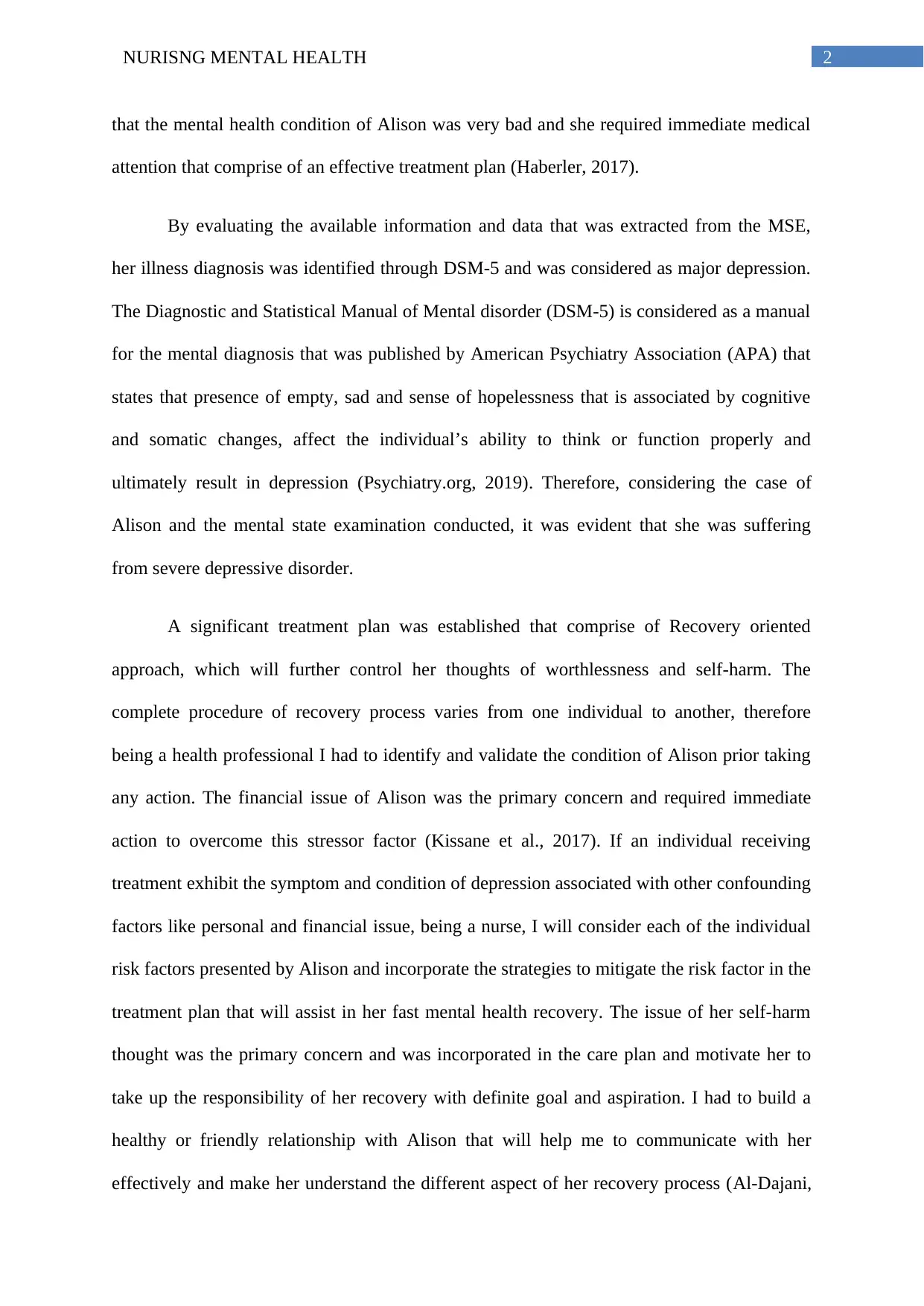
2NURISNG MENTAL HEALTH
that the mental health condition of Alison was very bad and she required immediate medical
attention that comprise of an effective treatment plan (Haberler, 2017).
By evaluating the available information and data that was extracted from the MSE,
her illness diagnosis was identified through DSM-5 and was considered as major depression.
The Diagnostic and Statistical Manual of Mental disorder (DSM-5) is considered as a manual
for the mental diagnosis that was published by American Psychiatry Association (APA) that
states that presence of empty, sad and sense of hopelessness that is associated by cognitive
and somatic changes, affect the individual’s ability to think or function properly and
ultimately result in depression (Psychiatry.org, 2019). Therefore, considering the case of
Alison and the mental state examination conducted, it was evident that she was suffering
from severe depressive disorder.
A significant treatment plan was established that comprise of Recovery oriented
approach, which will further control her thoughts of worthlessness and self-harm. The
complete procedure of recovery process varies from one individual to another, therefore
being a health professional I had to identify and validate the condition of Alison prior taking
any action. The financial issue of Alison was the primary concern and required immediate
action to overcome this stressor factor (Kissane et al., 2017). If an individual receiving
treatment exhibit the symptom and condition of depression associated with other confounding
factors like personal and financial issue, being a nurse, I will consider each of the individual
risk factors presented by Alison and incorporate the strategies to mitigate the risk factor in the
treatment plan that will assist in her fast mental health recovery. The issue of her self-harm
thought was the primary concern and was incorporated in the care plan and motivate her to
take up the responsibility of her recovery with definite goal and aspiration. I had to build a
healthy or friendly relationship with Alison that will help me to communicate with her
effectively and make her understand the different aspect of her recovery process (Al-Dajani,
that the mental health condition of Alison was very bad and she required immediate medical
attention that comprise of an effective treatment plan (Haberler, 2017).
By evaluating the available information and data that was extracted from the MSE,
her illness diagnosis was identified through DSM-5 and was considered as major depression.
The Diagnostic and Statistical Manual of Mental disorder (DSM-5) is considered as a manual
for the mental diagnosis that was published by American Psychiatry Association (APA) that
states that presence of empty, sad and sense of hopelessness that is associated by cognitive
and somatic changes, affect the individual’s ability to think or function properly and
ultimately result in depression (Psychiatry.org, 2019). Therefore, considering the case of
Alison and the mental state examination conducted, it was evident that she was suffering
from severe depressive disorder.
A significant treatment plan was established that comprise of Recovery oriented
approach, which will further control her thoughts of worthlessness and self-harm. The
complete procedure of recovery process varies from one individual to another, therefore
being a health professional I had to identify and validate the condition of Alison prior taking
any action. The financial issue of Alison was the primary concern and required immediate
action to overcome this stressor factor (Kissane et al., 2017). If an individual receiving
treatment exhibit the symptom and condition of depression associated with other confounding
factors like personal and financial issue, being a nurse, I will consider each of the individual
risk factors presented by Alison and incorporate the strategies to mitigate the risk factor in the
treatment plan that will assist in her fast mental health recovery. The issue of her self-harm
thought was the primary concern and was incorporated in the care plan and motivate her to
take up the responsibility of her recovery with definite goal and aspiration. I had to build a
healthy or friendly relationship with Alison that will help me to communicate with her
effectively and make her understand the different aspect of her recovery process (Al-Dajani,
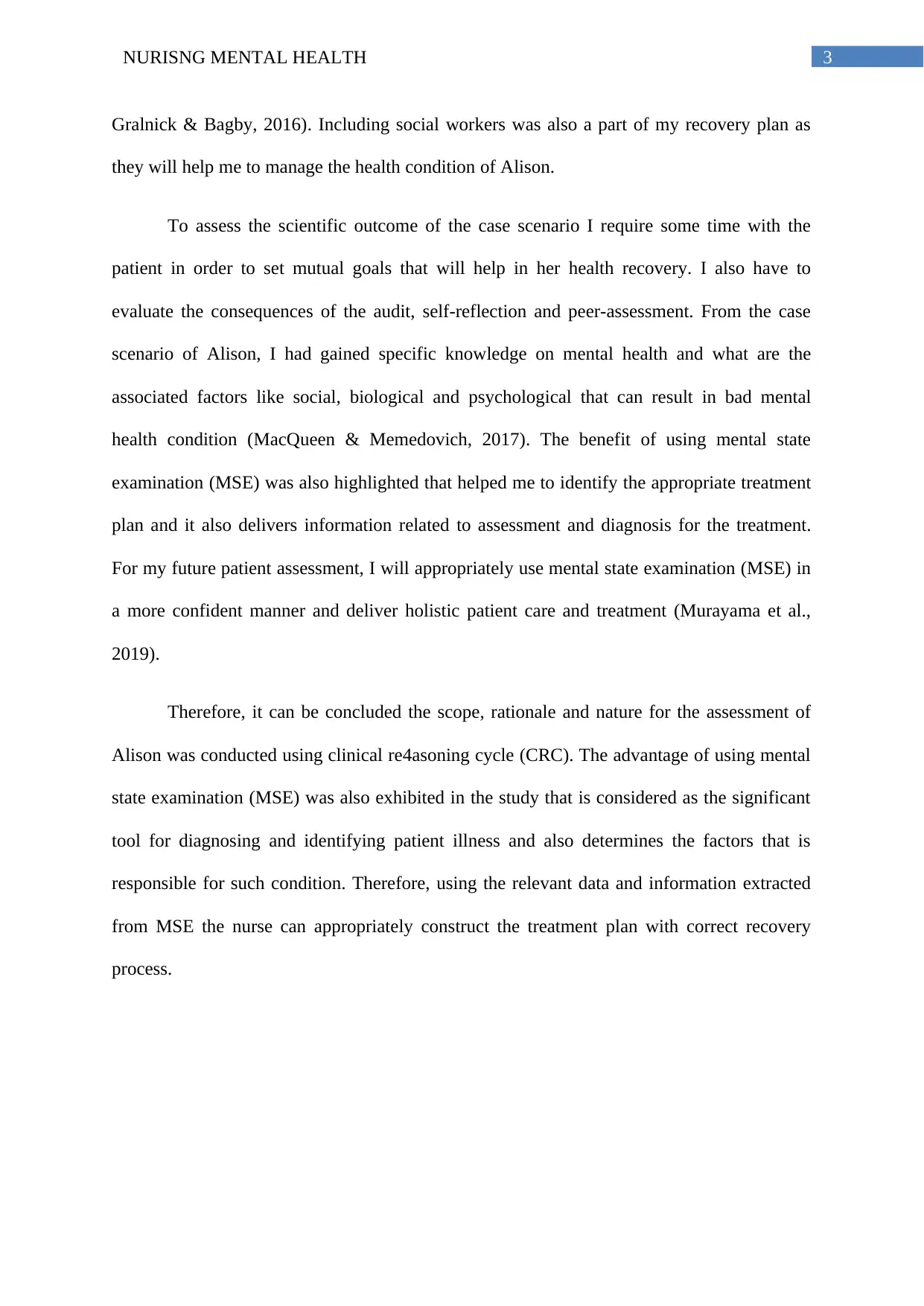
3NURISNG MENTAL HEALTH
Gralnick & Bagby, 2016). Including social workers was also a part of my recovery plan as
they will help me to manage the health condition of Alison.
To assess the scientific outcome of the case scenario I require some time with the
patient in order to set mutual goals that will help in her health recovery. I also have to
evaluate the consequences of the audit, self-reflection and peer-assessment. From the case
scenario of Alison, I had gained specific knowledge on mental health and what are the
associated factors like social, biological and psychological that can result in bad mental
health condition (MacQueen & Memedovich, 2017). The benefit of using mental state
examination (MSE) was also highlighted that helped me to identify the appropriate treatment
plan and it also delivers information related to assessment and diagnosis for the treatment.
For my future patient assessment, I will appropriately use mental state examination (MSE) in
a more confident manner and deliver holistic patient care and treatment (Murayama et al.,
2019).
Therefore, it can be concluded the scope, rationale and nature for the assessment of
Alison was conducted using clinical re4asoning cycle (CRC). The advantage of using mental
state examination (MSE) was also exhibited in the study that is considered as the significant
tool for diagnosing and identifying patient illness and also determines the factors that is
responsible for such condition. Therefore, using the relevant data and information extracted
from MSE the nurse can appropriately construct the treatment plan with correct recovery
process.
Gralnick & Bagby, 2016). Including social workers was also a part of my recovery plan as
they will help me to manage the health condition of Alison.
To assess the scientific outcome of the case scenario I require some time with the
patient in order to set mutual goals that will help in her health recovery. I also have to
evaluate the consequences of the audit, self-reflection and peer-assessment. From the case
scenario of Alison, I had gained specific knowledge on mental health and what are the
associated factors like social, biological and psychological that can result in bad mental
health condition (MacQueen & Memedovich, 2017). The benefit of using mental state
examination (MSE) was also highlighted that helped me to identify the appropriate treatment
plan and it also delivers information related to assessment and diagnosis for the treatment.
For my future patient assessment, I will appropriately use mental state examination (MSE) in
a more confident manner and deliver holistic patient care and treatment (Murayama et al.,
2019).
Therefore, it can be concluded the scope, rationale and nature for the assessment of
Alison was conducted using clinical re4asoning cycle (CRC). The advantage of using mental
state examination (MSE) was also exhibited in the study that is considered as the significant
tool for diagnosing and identifying patient illness and also determines the factors that is
responsible for such condition. Therefore, using the relevant data and information extracted
from MSE the nurse can appropriately construct the treatment plan with correct recovery
process.
Secure Best Marks with AI Grader
Need help grading? Try our AI Grader for instant feedback on your assignments.
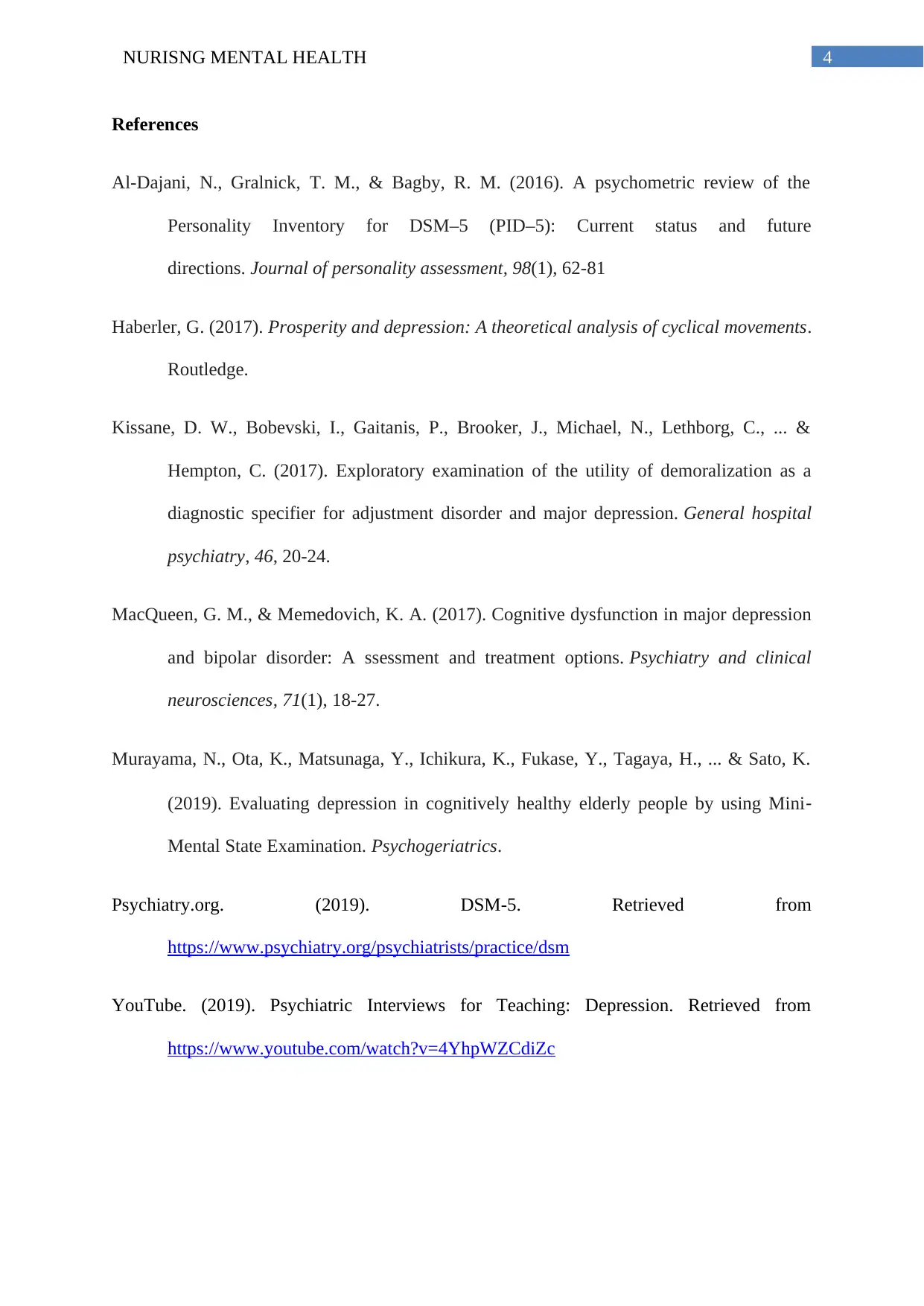
4NURISNG MENTAL HEALTH
References
Al-Dajani, N., Gralnick, T. M., & Bagby, R. M. (2016). A psychometric review of the
Personality Inventory for DSM–5 (PID–5): Current status and future
directions. Journal of personality assessment, 98(1), 62-81
Haberler, G. (2017). Prosperity and depression: A theoretical analysis of cyclical movements.
Routledge.
Kissane, D. W., Bobevski, I., Gaitanis, P., Brooker, J., Michael, N., Lethborg, C., ... &
Hempton, C. (2017). Exploratory examination of the utility of demoralization as a
diagnostic specifier for adjustment disorder and major depression. General hospital
psychiatry, 46, 20-24.
MacQueen, G. M., & Memedovich, K. A. (2017). Cognitive dysfunction in major depression
and bipolar disorder: A ssessment and treatment options. Psychiatry and clinical
neurosciences, 71(1), 18-27.
Murayama, N., Ota, K., Matsunaga, Y., Ichikura, K., Fukase, Y., Tagaya, H., ... & Sato, K.
(2019). Evaluating depression in cognitively healthy elderly people by using Mini‐
Mental State Examination. Psychogeriatrics.
Psychiatry.org. (2019). DSM-5. Retrieved from
https://www.psychiatry.org/psychiatrists/practice/dsm
YouTube. (2019). Psychiatric Interviews for Teaching: Depression. Retrieved from
https://www.youtube.com/watch?v=4YhpWZCdiZc
References
Al-Dajani, N., Gralnick, T. M., & Bagby, R. M. (2016). A psychometric review of the
Personality Inventory for DSM–5 (PID–5): Current status and future
directions. Journal of personality assessment, 98(1), 62-81
Haberler, G. (2017). Prosperity and depression: A theoretical analysis of cyclical movements.
Routledge.
Kissane, D. W., Bobevski, I., Gaitanis, P., Brooker, J., Michael, N., Lethborg, C., ... &
Hempton, C. (2017). Exploratory examination of the utility of demoralization as a
diagnostic specifier for adjustment disorder and major depression. General hospital
psychiatry, 46, 20-24.
MacQueen, G. M., & Memedovich, K. A. (2017). Cognitive dysfunction in major depression
and bipolar disorder: A ssessment and treatment options. Psychiatry and clinical
neurosciences, 71(1), 18-27.
Murayama, N., Ota, K., Matsunaga, Y., Ichikura, K., Fukase, Y., Tagaya, H., ... & Sato, K.
(2019). Evaluating depression in cognitively healthy elderly people by using Mini‐
Mental State Examination. Psychogeriatrics.
Psychiatry.org. (2019). DSM-5. Retrieved from
https://www.psychiatry.org/psychiatrists/practice/dsm
YouTube. (2019). Psychiatric Interviews for Teaching: Depression. Retrieved from
https://www.youtube.com/watch?v=4YhpWZCdiZc

5NURISNG MENTAL HEALTH
1 out of 6
Related Documents
Your All-in-One AI-Powered Toolkit for Academic Success.
+13062052269
info@desklib.com
Available 24*7 on WhatsApp / Email
![[object Object]](/_next/static/media/star-bottom.7253800d.svg)
Unlock your academic potential
© 2024 | Zucol Services PVT LTD | All rights reserved.





